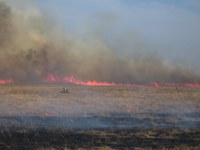Fire Benefits Grasslands of the Dakotas
(Click the image below to view a high-resolution image that can be downloaded)
Fire and grazing are essential ecosystem tools for dealing with today’s rangelands, a North Dakota State University rangeland expert says.
“Fire was, and still is, a natural disturbance to our rangelands, and depending on the timing of the burn, can create both long- and short-term benefits and potential production losses,” says NDSU Extension Service rangeland management specialist Kevin Sedivec. “And, fire will have no long-term negative impacts on plant community composition or production. Even more interesting, properly timed, prescribed fires can create positive impacts on plant species diversity and forage production, creating a healthier, more productive rangeland for a variety of species.”
The impact of fire on the northern Plains grasslands has become a hot issue of debate in the wake of the Pautre wildfire near Lemmon, S.D., earlier this spring. The fire has raised a number of questions: Is fire good or bad? Does it destroy, and do we “lose,” these rangelands? Does a need really exist for prescribed burns on range management?
“These are common questions that need to be addressed for land managers to better understand the role of fire in managing range and grasslands in the Dakotas,” Sedivec says.
For decades, several researchers have studied the effects of fire on plants and wildlife habitat in the northern Plains. Fire and grazing often are viewed as rangeland management tools, but seldom in combination.
Discussions on fire and rangelands need to focus on the impacts as they relate to wildfires and prescribed burns, according to Sedivec. The short-term impacts of a wildfire primarily are dependent on when it occurs during the growing season and the heat duration of the fire. Because northern Plains plants evolved with fire, grass fires typically don’t sustain heat long enough to have undesirable consequences. However, data documenting the impacts of fire on plant species composition and forage production in the Dakotas is limited.
“What we know is early spring fires, such as what was experienced during the Pautre fire, tend to have little impact on grassland plants in terms of plant composition or forage production,” Sedivec says. “These types of fire will remove standing dead plant tissue, release nutrients for plant growth, improving water cycling, and increase the nutritional quality and taste of plants that livestock and wildlife would normally ignore.”
He says an excellent example of the value of a prescribed early spring fire is that it removes unpalatable crested wheatgrass plants, which are replaced by new crested wheatgrass plants that are lush and desirable to grazing animals. This practice provides a higher nutritional grass that livestock readily consume, rather than ignore, while allowing the native vegetation to grow and not be overgrazed. Through time, the invasive, exotic crested wheatgrass can be reduced from the plant community and replaced by many native grass species.
Late-spring (mid-May to early June) fires tend to be excellent in providing short-term production losses of invasive grasses such as Kentucky bluegrass and smooth bromegrass. These fires generally increase the production and composition of warm-season native grasses with little impact to cool-season native grasses.
In the eastern Dakotas, late-spring fires tend to increase the overall forage production, especially warm-season grasses such as big bluestem, switchgrass, Indiangrass and prairie sandreed. In the western Dakotas, these types of fires tend to have no effect on native plant species’ composition and little to no effect on forage production. However, during dry springs, these fires can reduce the short-term forage production potential.
“The impact of summer fire is really unknown and quite variable,” Sedivec says. “These types of fires tend to occur when environmental conditions include high temperatures and limited precipitation. Summer fires not only remove the above-ground plant material, but also create bare soil that can become hot, impacting the recovery period and possibly decreasing short-term forage production potential.”
Environmental conditions must be considered when evaluating the impact of summer fires, he adds. However, summer fires appear to injure exotic, invading cool-season grasses such as Kentucky bluegrass and smooth bromegrass.
Late-summer and early fall fires appear to have no impact on plant species’ composition based on limited studies conducted in western North Dakota. These fires may decrease forage production potential during the subsequent year following the fire, but production fully recovers 12 to 24 months following the fire, depending on moisture conditions.
This type of fire severely injures club moss, a pesky weed found on western rangelands of the Dakotas, and kills juniper trees and some shrubs. Although juniper trees should grow on specific landscapes and habitats, many of these trees should not be growing on the true rangeland sites. When these invaded tree sites are burned, the native plant species’ composition increases as the trees die off, creating a more sustainable, properly functioning ecosystem.
These benefits clearly indicate that fire is a tool that must be included in management strategies for rangeland and grasslands in the northern Plains, Sedivec believes.
“Fire not only can be used to manipulate the grazing patterns of livestock, but it also can be used to control invasive grasses,” he says. “Introduced cool-season grasses are North and South Dakota’s No. 1 problem in negatively impacting the forage value, wildlife habitat quality, hydrology, nutrient cycling and the scenic beauty of our rangelands.
“Fire, in combination with grazing, is the best tool we have available to combat the invasion of exotic cool-season grasses and undesirable woody encroachment,” he notes. “We will not stop the invasion of Kentucky bluegrass (better known as our lawn grass), smooth bromegrass, crested wheatgrass or woody encroachment onto native range without fire.”
NDSU Agriculture Communication - June 10, 2013
| Source: | Kevin Sedivec, (701) 231-7647, kevin.sedivec@ndsu.edu |
|---|---|
| Editor: | Ellen Crawford, (701) 231-5391, ellen.crawford@ndsu.edu |


